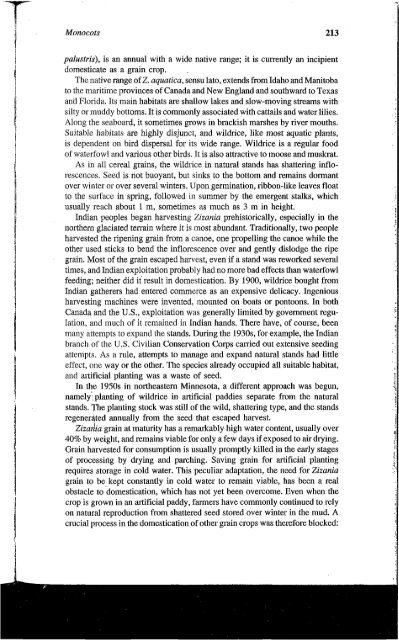Sauer - 1993 - Historical geography of crop plants, a select rost
Sauer - 1993 - Historical geography of crop plants, a select rost
Sauer - 1993 - Historical geography of crop plants, a select rost
Create successful ePaper yourself
Turn your PDF publications into a flip-book with our unique Google optimized e-Paper software.
214 <strong>Historical</strong> Geography <strong>of</strong> Crop Plants: A Select Roster<br />
automatic <strong>select</strong>ion <strong>of</strong> mutations for nonshattering was not begun by planting<br />
harvested grain.<br />
Finally during the 1960s, deliberate <strong>select</strong>ion <strong>of</strong> mutations that reduced<br />
shattering was begun in Minnesota, first by private entrepreneurs and then by<br />
a University <strong>of</strong> Minnesota breeding program. These cultivars were rapidly<br />
adopted for planting artificial wildrice paddies in northeastern Minnesota.<br />
They allowed machines to harvest in one operation three times the grain<br />
obtained by repeated harvests <strong>of</strong> the shattering forms. However, the farmers<br />
usually continued to rely on reproduction by the grain that escaped harvest.<br />
In the 1980s, Zizania cultivation on a much larger scale was begun far<br />
outside the native range in California’s Sacramento Valley. This is a region<br />
where paddy cultivation <strong>of</strong> Oriental rice has long been important. Some new<br />
shatter-resistant cultivars were <strong>select</strong>ed locally. More importantly, the California<br />
farmers generally practiced cold storage and sowing <strong>of</strong> harvested grain.<br />
The paddies, in a region <strong>of</strong> expensive irrigation water and high evaporation,<br />
were not maintained as permanent artificial marshes, but were drained and<br />
allowed to dry between wildrice <strong>crop</strong>s. Sometimes the land was rotated to<br />
Oriental rice or other <strong>crop</strong>s. As a result, intense automatic <strong>select</strong>ion for ¡ess<br />
shattering and less dormancy began. It should be interesting to see how rapidly<br />
this may produce a truly domesticated cultivar, dependent on harvesting and<br />
sowing.<br />
By the mid-1980s, California growers had more than 6000 ha <strong>of</strong> wildrice,<br />
with average harvests ten times the maximum obtained from native stands and<br />
accounting for about half <strong>of</strong> the world <strong>crop</strong>. This was too much wildrice for<br />
the existing market demand, and large stocks remained in storage with reduced<br />
planting as a result. The <strong>crop</strong> is costly to grow, largely because viable seed<br />
is expensive and much <strong>of</strong> it remains dormant after sowing. Also, much <strong>of</strong> the<br />
wildrice <strong>crop</strong> is harvested by flocks <strong>of</strong> redwing blackbirds. Whether Zizania<br />
will ever join Oryza as a staple rather than a luxury remains to be seen.<br />
H ORD EUM — BARLEY (Bar-Yosef and Kislev 1989; Bender 1975; Harlán*<br />
1975, 1976; Murray 1970; Wiehe 1968; Zohary and Hopf 1988)<br />
Hordeum includes about 25 species native to the north temperate regions,<br />
mainly in open, dry habitats. Some are tolerant <strong>of</strong> salinity and alkalinity. Most<br />
are weedy and have spread in artificially disturbed sites. A single wild species<br />
H. spontaneum is the progenitor <strong>of</strong> all the cultivated barleys.<br />
H. spontaneum {=H. vulgare subsp. spontaneum) today ranges widely through<br />
the Levant and southwestern Asia as an agricultural weed. However, truly wild<br />
populations occupying natural habitats are concentrated in a coherent arc, the<br />
so-called Fertile Crescent, extending from the Jordan Valley northward to the<br />
Anatolia-Syria border region and then curving eastward along the Iran-Iraq<br />
border region. Wild barley and wheats are important members <strong>of</strong> the winter<br />
annual grassland and oak parkland <strong>of</strong> this Mediterranean climatic region. As<br />
the long summer drought sets in, they quickly mature a large <strong>crop</strong> <strong>of</strong> grain.

















